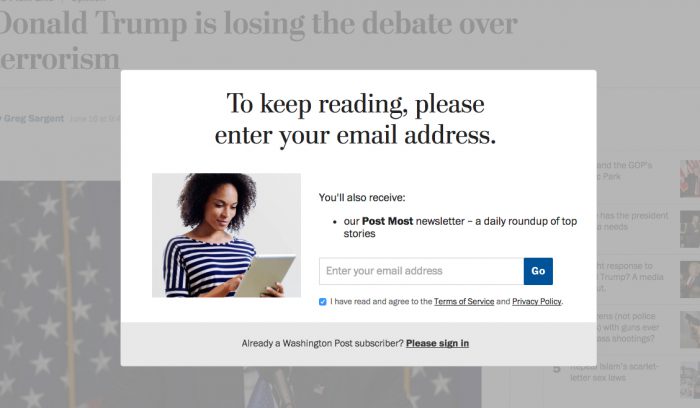
Even as it boasts of record traffic, The Washington Post is apparently looking at ways to make it a little more difficult for people to read its journalism for free. Numerous social media users are reporting that the paper is taking steps to get more information about readers, and the paper has taken steps to close loopholes that let readers access stories for free via social media.
Some readers who aren’t logged into the Post’s site are getting a pop up that asks them to provide their email address and subscribe to the the paper’s Post Most daily newsletter.

Some users reported that the offer included six free weeks of access to the Post as well.
Washington Post now requires a free six-week subscription, forcing you to get a email newsletter to read an article pic.twitter.com/SqjmAkAtYM
— Patrick deHahn (@patrickdehahn) June 15, 2016
(Update: A Post spokeswoman said she wouldn’t be able to provide details about the changes today, but did note that “there has been a change where access to content from social is no longer unlimited.”)
Others were unhappy that the Post was asking for their email address, and some said that they wanted to share their email, but that the system wasn’t working.
No, @washingtonpost, I will not enter my email address to continue. Not even my junk one. See you later. pic.twitter.com/bbv0IslBQ0
— Cody Kirkpatrick (@codykirkpatrick) June 15, 2016
I'm surprised that @washingtonpost knows that "lolcat@butts.com" is not a valid email addr… https://t.co/qCZFfmCYUY pic.twitter.com/juH5Ey6Db2
— Jamie Smyth (@JamieMSmyth) June 16, 2016
Dear @washingtonpost, I would happily give you my email and subscribe but your site keeps telling me my address is "invalid." ☹️
— Celeste Ng (@pronounced_ing) June 14, 2016
When the Post launched its paywall in 2013, it was a little leakier than most, with exceptions for those logging in from schools, government offices, and military installations. Stories accessed through search or social media also didn’t count against the paywall, but the Post has now closed that loophole.
hey @washingtonpost how come the paywall comes up when I access articles via social media? that never happened before…
— Michael Crispino (@MJCrispino) June 17, 2016
@marstall Hmmm … sounds like there’s been a change. Social didn’t count when paywall went into effect. @washingtonpost
— Dan Kennedy (@dankennedy_nu) April 25, 2016
The Post says it had 63 million unique visitors in May, a 32 percent increase from May 2015. (Notably though, after it trumpeted surpassing The New York Times in unique visitors late last year, the Times again overtook the Post with 69 million unique visitors in May.)
Though it highlights the size of its audience, the Post’s moves seem to highlight a continued recognition that news organizations won’t be able to survive on digital advertising alone. And the Post isn’t the only outlet that’s tightened up its paywall. Publishers are looking to squeeze as much money and information as they can out of readers as digital advertising revenue dries up. The annual Pew State of the Media Report, which was released last week, said that five companies — Google, Facebook, Yahoo, Microsoft, and Twitter — captured 65 percent of the $59.6 billion spent on digital advertising last year.Earlier this year, The Wall Street Journal experimented with closing a loophole in its paywall that let readers access stories for free by googling its headline. This spring, The New York Times also began limiting free access from social media.
In 2013, The Boston Globe tightened its paywall, only allowing readers who came in from social two articles per month for free. (In 2014, the Globe dropped its hard paywall and implemented a metered system.) At the time, a Globe spokeswoman said the paper was “trying to find the optimal balance between a free, ad-supported model and a premium, consumer-supported model.” “This is part of an effort to continually experiment, test and analyze how our readers engage with us digitally,” she said. “We have been trying to find the right balance between the free-sharing culture of the Internet and paid access to premium Globe content. We believe that we can only arrive at that balance through experimentation.”